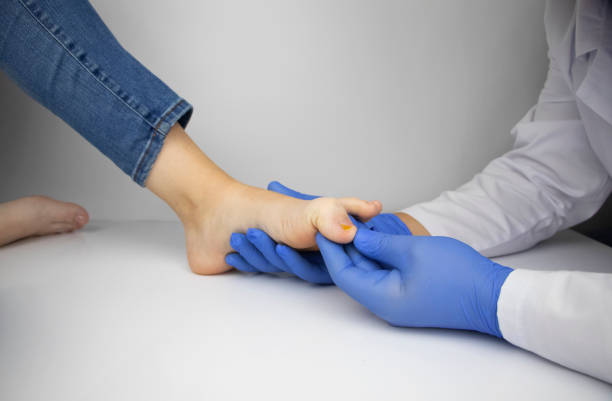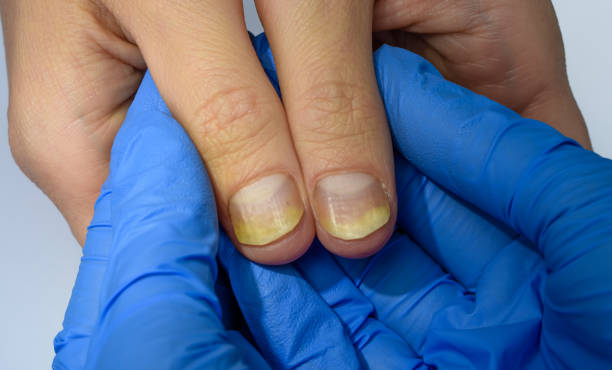Fungal nails (onychomycosis) are usually caused by microscopic fungi that enter through cracks in the nail or the surrounding skin. These infections are most common in the toenails but can also affect fingernails.
Fungi often cause severe nail infections that are hard to cure. Treatment options include antifungal tablets and medication that you apply to the nail or skin.

Prevention
Despite their unsightly appearance, fungal nail infections are typically painless. But they can cause discomfort in some cases and are often contagious. Board-certified dermatologists offer preventive measures that can help keep your nails healthy and free of infection.
Fungi are naturally found in the world around us. They enter the nail through small cracks and grow in a person’s nails, causing an infection. Usually, the infection spreads from one person to another in damp areas like public showers, locker rooms, spas and pools. It can also be passed along when people wear the same footwear or socks. To avoid picking up an infection, it’s best to not share shoes, nail clippers, or other personal items. Wash your feet every day, making sure to wash and dry them carefully. Wear shoes that fit well and allow room for your toes. If possible, wear flip flops when walking in warm, moist areas.
A nail fungus is more common in older adults, due to slower-growing nails and reduced blood circulation in the feet and toes. Diabetes and other conditions that impair the body’s natural function of regulating temperature and blood circulation can also increase the risk for a fungal nail infection. In addition, repetitive trauma to the nail plate (such as stubbing your toe) can damage the surface and let fungus in.
Medications
Many people with fungal nail infections have tried over-the-counter antifungal creams and ointments, but these treatments are often not strong enough to cure the infection. These treatments also don’t prevent a fungal nail infection from returning, so it is important to use them for as long as your doctor recommends.
If over-the-counter antifungal treatments don’t work, your doctor might try another medication that you take orally, such as terbinafine (Lamisil(r)), itraconazole (Sporanox(r)), or fluconazole (Diflucan(r)). These medications aren’t safe for everyone and can affect the liver, so you may need blood tests every month to check how well they are working.
In some cases, a dermatologist can prescribe medicine that you apply directly to your nails. These medications typically have a higher cure rate than oral medicines, but they can be more difficult to use. You will need to apply the nail medicine regularly and correctly, usually twice a day, for six to 12 months.
One option is tavaborole 5% solution, which was shown to be effective in two phase III randomized controlled trials that each lasted 48 weeks. This topical treatment works by penetrating the nail plate and blocking the formation of new fungus cells, according to research published in 2015. Other prescription options include Penlac (ciclopirox), which is available as a brush-on lacquer. This medication has a complete cure rate of about 8.5% in patients with mild to moderate onychomycosis.

Surgery
If your fungal nail infection is not responding to over-the-counter or prescription medication, Perth fungal nail treatment can help you. This can include using a topical medication to kill the infection or even having surgery to remove the infected nail.
In many cases, the fungus that causes a fungal nail infection is not visible to the naked eye. But the fungus is still present, and it can be spread to other nails and to other people. To be effective, antifungal treatments need to penetrate the fungal biofilm under the nail and reach the spores that are hiding in the grooves of your nails and under the cuticle folds.
We often file the nails down to help these medications get in to the fungus and attack it. We also recommend keeping the nails trimmed short to reduce pressure on them and to make them easier for medication to reach. If you see dark spots or streaks on the nails that are not caused by injury and do not respond to antifungal medication, you should call a dermatologist immediately. This could be a serious condition called melanoma.
Fungi love warm and moist environments, such as public showers and pools, so it is easy to catch a nail infection by walking barefoot in these places or bringing the fungus from home in your footwear. It is important to always wear shoes that cover your feet, especially in public areas, and to change your socks and shoes often. You should also try to avoid walking barefoot in public locker rooms, bathrooms, and spas. You should also avoid sharing personal items, such as towels and nail clippers, with other people.
Other Treatments
Your doctor can prescribe oral (taken by mouth) antifungal medications such as terbinafine (Lamisil(r)), itraconazole (Sporanox(r)), or fluconazole (Diflucan(r)). You’ll need to take these tablets daily for several months or longer. Oral antifungals are usually more effective than topical medications. However, the drugs can affect your liver and interact with other medications. Oral treatment isn’t suitable for everyone, including those with diabetes.
You can also get a prescription for a medicated nail polish that contains an antifungal agent, such as ciclopirox (Penlac(r)). This type of nail polish is applied daily and soaked for seven days to allow the medication to penetrate the nails. Your doctor may advise you to thin your nails by filing them before applying the product, since thick nails can interfere with its penetration. You must continue this regimen daily for up to a year to cure the infection.
Fungus is usually a mild condition that doesn’t cause pain, but it can become more severe and lead to discolored and thickened nails. It is more common in toenails than fingernails and can occur in anyone. Avoid infections by keeping your feet clean and dry. Wear shoes that fit well and are made of breathable materials. Wear shoe covers in locker rooms and public showers and change your socks frequently. Keep your nails trimmed and file off any white markings that appear.